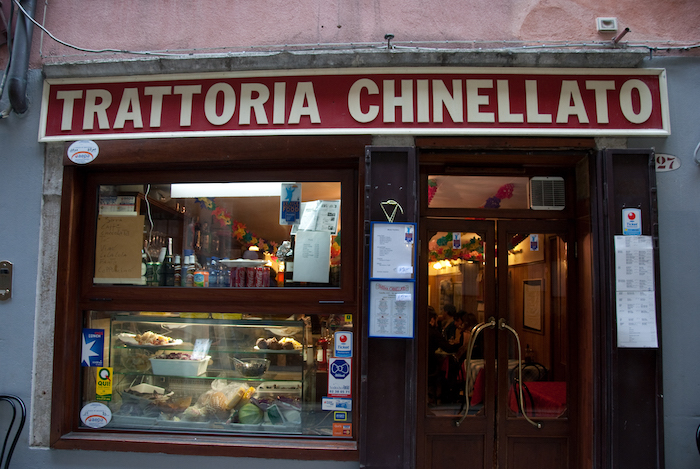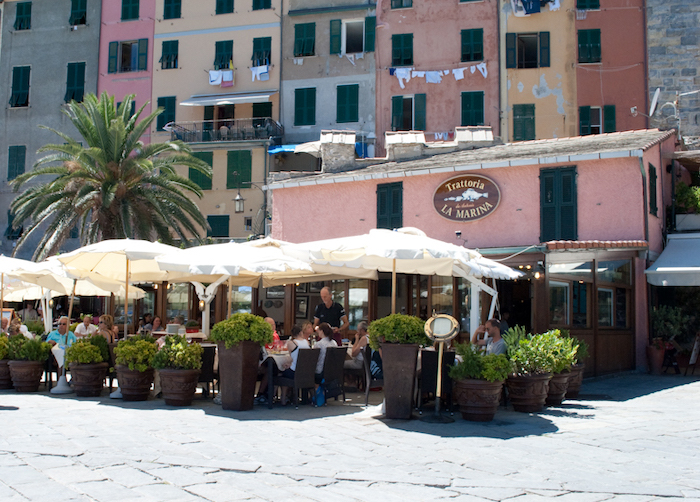When we used to live in Turin, we’d never let a week go by without a trip to one of our favourite local restaurants. After all, there is nothing quite like Italian cuisine!
Ristorante (plural: ristoranti) is the Italian word for restaurant and as you can see, the spelling is very similar to the English word.

If you refer to a place simply as a ristorante, the implication is that it is a formal, high quality establishment with excellent service and prices to match. You can expect antipasti (appetisers), primi (first courses), secondi (main courses), contorni (side dishes), and dolci (desserts).
Siamo andati in un ristorante di pesce l’altro giorno.
We went to a seafood restaurant the other day.

Of course not all restaurants in Italy fall into this category. Below is a list of other types you will likely encounter.
Pizzeria

As the name suggests, the pizzeria is a kind of restaurant that primarily serves pizza. However you may also find other items on the menu including pasta and salad. Most pizzerie are have a simple decor and a homely ambiance, but some establishments also offer a full “ristorante-like” service. They are a favourite amongst workers on their pausa pranzo (lunch break) because the service is quick and the food is generally affordable.
Hint: If a word ends in the suffix -eria as in pizzeria, more often than not it refers to an establishment that sells a specific kind of food and/or drink! Some other examples are gelateria (ice cream), birreria (beer), pasticceria (pastry) and panetteria (bread).
Trattoria

A trattoria is a kind of restaurant that is generally less formal than a ristorante, but more formal than an osteria. They are usually family run and offer a several traditional dishes from that particular region. In Torino, for example, many trattorie serve vitello tonnato and tajarin, both of which are local Piedmonese delicacies.
Osteria
Many people tend to confuse trattorie and osterie and I can hardly blame them! The truth is that the differences aren’t nearly as clear cut as they used to be. These days, both serve food and tend to be family run establishments, whereas in the past, people used to go to their local osteria primarily to drink wine and socialise.
Tavola calda / Tavola fredda
In Italy, you’ll find a bar (the word for cafe in Italian) on every corner, sometimes even next to each other. Bar are popular places to get an espresso or a cappuccino, which Italians often drink more than once in a day.
The bar can also be the ideal place to grab a quick lunch when you don’t want to spend a lot or when you don’t have much time to spare. On the menu or the board outside you’ll often find these words: tavola calda (hot table) and tavola fredda (cold table).
At the former, you can expect warm food whereas the latter only provides cold dishes such as panini (sandwiches). Some bars can serve primi, secondi and contorni but the selection isn’t as rich as a ristorante. They don’t usually stay open in the evening.
Rosticceria
The rosticceria is very similar to the tavola calda in that they serve pre-made food to take home with you or eat on the premises. As the name suggests, there are usually roasted cuts of meats on offer.
Taverna / Tavernetta
In the past, a taverna was a pub of low rank that would serve food and wine to the common folk. Today, the term has been adapted to places with a much higher rank like ristoranti and trattorie. They can even be luxury establishments with rustic furniture. They’re often open in the evening.
Important words and phrases:

If you plan on treating yourself to a meal out in Italy, here are a few terms and phrases that will come in handy when making a reservation, ordering and paying the bill:
- prenotare = to book, reserve
- ordinare = to order
- la mancia = tip
- da portare via = take-away
- un tavolo per due / quattro = a table for two / four
- il conto = the bill
- menù = menu
- coperto = service charge
- posate = cutlery
Vorrei / Posso avere un bicchiere di vino?
I would like / Can I have a glass of wine?
Mi scusi, avevo ordinato un dolce… – Controllo subito signorina!
Excuse me, I ordered a dessert… – I’ll check right away, miss!
Mi può portare il conto per favore?
Can you bring me the bill please?
Vorrei prenotare un tavolo per due, per favore.
I’d like to reserve a table for two, please.
Non è obbligatorio lasciare la mancia in Italia ma i camerieri lo apprezzeranno.
It isn’t obligatory to leave a tip in Italy but the waiters will appreciate it.
È possibile portare il resto a casa?
Is it possible to bring the rest home?
Heather Broster is a graduate with honours in linguistics from the University of Western Ontario. She is an aspiring polyglot, proficient in English and Italian, as well as Japanese, Welsh, and French to varying degrees of fluency. Originally from Toronto, Heather has resided in various countries, notably Italy for a period of six years. Her primary focus lies in the fields of language acquisition, education, and bilingual instruction.


